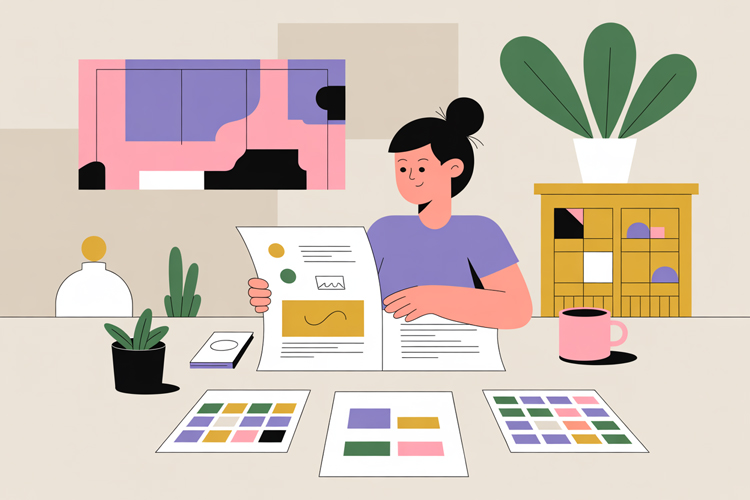
Even with all the focus on digital marketing, there’s still something powerful about a well-designed brochure you can hold in your hand. It’s tangible, it builds credibility, and it gives your audience a quick way to understand who you are and what you do.
But here’s the catch: a brochure only works when it’s planned and written with purpose.
If you’re not sure what to include, or you just want to make sure you don’t miss anything, this guide breaks down every section you need for a professional, results-driven brochure.
Why Brochures Still Matter in 2025
Brochures are far from outdated. They’ve simply evolved.
A modern company brochure does more than showcase services—it tells your story, reinforces your brand, and builds trust in a way a quick social post can’t. Whether you hand it out at trade shows, send it with proposals, or share a digital PDF version online, a well-crafted brochure can:
-
- Make your company look established and credible
- Give your sales team a tangible leave-behind tool
- Summarize your products or services clearly
- Support your website and other marketing materials
So let’s get into what goes inside a brochure that actually works.
Step 1: Define the Purpose Before You Design
Before jumping into content or visuals, ask one key question:
“What do I want this brochure to do?”
The answer determines everything—from layout to tone. Here are some common brochure goals:
-
- Introduce your company to new prospects
- Highlight a specific service or product line
- Support sales meetings or trade shows
- Educate customers about a process or solution
- Reinforce your brand after a presentation or quote
When you know the goal, you can shape your content to drive that outcome.
Step 2: Start with the Essentials
Here’s your core checklist—the must-have elements every company brochure should include.
1. Clear Headline or Tagline
The first line your reader sees should instantly tell them what you do or what benefit you provide.
Keep it short, direct, and customer-focused.
Example:
“Building Stronger Communities Through Reliable Construction Services”
or
“Professional Marketing Design That Moves Your Business Forward”
2. Company Overview
A short paragraph that sums up who you are and what makes your company different.
Avoid industry jargon—focus on results and credibility.
Example:
“Brochure Builders is a Texas-based design agency helping businesses nationwide create professional marketing materials that look sharp, print beautifully, and actually generate results.”
3. Products or Services
This is the heart of your brochure. Present your main offerings clearly and visually.
Tips:
-
- Use short descriptions or bullet points, not long paragraphs
- Include one clear photo or icon per service
- Highlight what’s most profitable or unique
4. Key Benefits
Don’t just list what you do—show why it matters.
Answer the reader’s unspoken question: “What’s in it for me?”
Example:
-
- Save time with ready-to-print designs
- Consistent branding across every touchpoint
- Affordable flat-rate packages
5. Visuals and Photography
Images make or break a brochure.
Use professional photos or clean vector graphics that support your message.
Avoid generic stock imagery whenever possible. Instead, feature:
-
- Your team at work
- Products in use
- Real project examples
- Customer interactions
6. Social Proof
If you have space, add a short testimonial or client quote.
Nothing builds trust faster than seeing proof that others are happy with your work.
Example:
“Our new brochure design doubled the number of leads from trade shows.” — Wayne S., Restaurant Owner
7. Call to Action
Every brochure needs a next step.
Tell the reader exactly what you want them to do next—don’t assume they’ll know.
Examples:
-
- “Visit our website to get a free quote.”
- “Book a 15-minute call with our design team.”
- “Email us your project details to get started.”
8. Contact Information
Make it easy to reach you.
Include your website, phone number, email, and physical location (if applicable).
Also add your logo, social handles, and a QR code that links directly to your site or booking page.
Step 3: Add Optional Elements That Build Credibility
If you have space and it fits your goal, these extras can add real value:
-
- Client logos (especially recognizable names)
- Case study highlights (“Increased engagement by 35%”)
- Awards or certifications
- Team photos or leadership spotlight
- A short brand story or mission statement
These details create connection and help humanize your business.
Step 4: Plan Your Layout — Page by Page
Here’s a simple way to think through your layout flow:
| Brochure Section | Purpose |
|---|---|
| Front Cover | Grab attention with a clear headline, logo, and an engaging image. |
| Inside Left Panel / Page 2 | Brief company intro or story. |
| Inside Center / Page 3–4 | Core services or products with visuals. |
| Inside Right / Page 5–6 | Benefits, testimonials, or case studies. |
| Back Cover | Call to action and full contact information. |
If you’re designing something longer (like a 12-page catalog or booklet), apply the same logic—each spread should guide the reader forward with clarity.
Step 5: Avoid These Common Brochure Mistakes
-
- Too much text. Keep it scannable—use headings, subheads, and white space.
- No clear hierarchy. Make the most important points visually dominant.
- No defined goal. Every brochure should drive a specific action.
- Low-quality printing or paper. It cheapens your brand instantly.
- Poor image quality. Blurry or pixelated photos can ruin even great design.
Step 6: Review, Print, and Distribute with Intention
Before you send your brochure to print, double-check:
-
- Spelling, grammar, and contact info
- Image resolution (300 DPI minimum)
- Color consistency (CMYK for print)
- Margins and bleed settings (ask your printer if unsure)
Then, think about distribution:
-
- Include brochures in new client packets
- Hand them out at trade shows and networking events
- Send digital versions as PDFs in follow-up emails
Final Thoughts
A company brochure is more than a marketing piece—it’s a reflection of your brand’s credibility.
When you include the right mix of content, design, and strategy, it becomes a tool that keeps working long after you hand it out.
If you’re ready to create a brochure that actually gets noticed and helps your business grow, our team at Brochure Builders can help you design, print, and deliver a professional piece that stands out.
👉 Explore our brochure design packages and see how easy it can be to elevate your marketing.







